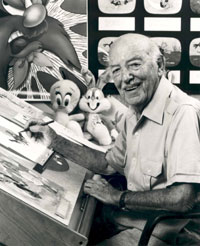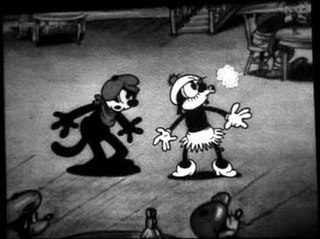Related Research Articles

George Joseph Herriman III was an American cartoonist best known for the comic strip Krazy Kat (1913–1944). More influential than popular, Krazy Kat had an appreciative audience among those in the arts. Gilbert Seldes' article "The Krazy Kat Who Walks by Himself" was the earliest example of a critic from the high arts giving serious attention to a comic strip. The Comics Journal placed the strip first on its list of the greatest comics of the 20th century. Herriman's work has been a primary influence on cartoonists such as Elzie C. Segar, Will Eisner, Charles M. Schulz, Robert Crumb, Art Spiegelman, Bill Watterson, and Chris Ware.

Isadore "Friz" Freleng, credited as I. Freleng early in his career, was an American animator, cartoonist, director, producer, and composer known for his work at Warner Bros. Cartoons on the Looney Tunes and Merrie Melodies series of cartoons from the 1930s to the early 1960s. In total he created more than 300 cartoons.

Krazy Kat is an American newspaper comic strip, created by cartoonist George Herriman, which ran from 1913 to 1944. It first appeared in the New York Evening Journal, whose owner, William Randolph Hearst, was a major booster for the strip throughout its run. The characters had been introduced previously in a side strip with Herriman's earlier creation, The Dingbat Family, after earlier appearances in the Herriman comic strip Baron Bean. The phrase "Krazy Kat" originated there, said by the mouse by way of describing the cat. Set in a dreamlike portrayal of Herriman's vacation home of Coconino County, Arizona, KrazyKat's mixture of offbeat surrealism, innocent playfulness and poetic, idiosyncratic language has made it a favorite of comics aficionados and art critics for more than 80 years.

The Apache Kid is a 1930 cartoon short distributed by Columbia Pictures and features Krazy Kat. The film is the character's 149th film.
Lil' Ainjil is a 1936 short animated film distributed by Columbia Pictures, and features Krazy Kat.
Love's Labor Lost is a 1920 short, animated film by Bray Productions and is one of the silent Krazy Kat cartoons. The film's title references a play by William Shakespeare.

Rail Rode is a 1927 silent short animated film released by Paramount featuring Krazy Kat.
The Mouse Exterminator is a 1940 short animated film in the Phantasies series, produced and distributed by Columbia Pictures. It marks the final theatrical appearance of Krazy Kat, the title character from George Herriman's comic strip.
Birth of Jazz is a 1932 short animated film by Columbia Pictures, featuring Krazy Kat.
Krazy Kat and Ignatz Mouse: A Duet, He Made Me Love Him, also simply known as A Duet, is a 1916 silent short animated film featuring Krazy Kat. It is among the earliest cartoons to feature Krazy who earlier achieved modest success through comic strips.
The Best Mouse Loses is a 1920 silent short theatrical cartoon by Bray Productions featuring Krazy Kat.
The Peace Conference is a 1935 short animated film by Columbia Pictures, featuring the comic strip character Krazy Kat.
Out of the Ether is a 1933 short animated film distributed by Columbia Pictures, featuring Krazy Kat.
The Great Cheese Robbery is a silent short animated film made by Bray Productions featuring Krazy Kat. It marks the first Krazy film produced by Bray after the International Film Service (IFS) ended its run in making films in the series.
A Family Affair is a silent short animated film by Bray Productions featuring Krazy Kat. It is the sixth Krazy short produced by the studio.
The Autograph Hunter is a 1934 short animated film distributed by Columbia Pictures, featuring the comic strip character Krazy Kat as well as some caricatures of well-known actors of the time.
The Awful Spook is a silent short animated film created by the Bray Studio, featuring Krazy Kat.
Stomach Trouble is a 1927 silent animated short starring the comic strip character Krazy Kat. The short was released by Winkler Pictures.
The Dingbat Family is a comic strip by American cartoonist George Herriman that ran from June 20, 1910, to January 4, 1916. It introduced Herriman's most famous pair of characters: Krazy Kat and Ignatz Mouse, who later featured in Herriman's best-known strip Krazy Kat (1913–1944).
Events in 1916 in animation.
References
- ↑ Lenburg, Jeff (1999). The Encyclopedia of Animated Cartoons. Checkmark Books. pp. 34–35. ISBN 0-8160-3831-7 . Retrieved 6 June 2020.